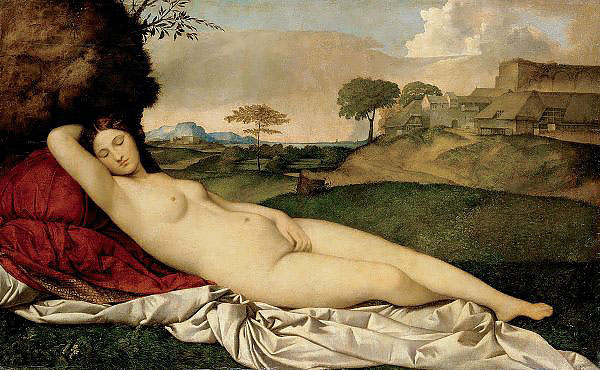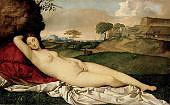Sleeping Venus 1510 By Giorgione
Giorgione, Famous Nude Painting Sleeping Venus c1510
Giorgione's Sleeping Venus is a popular oil painting of famous Renaissance art. Giorgione was a prominent Venetian School of Art figure during the early 16th century.
Giorgione’s famous nude painting uses a triangular shape to create balance and harmony in the composition. The colors used are soft and muted, creating a dreamlike atmosphere. He employs a technique called sfumato, which involves gradually blending colors and tones to create a smooth transition between different elements.
Symbolism plays a significant role in Giorgione’s Sleeping Venus painting. It represents the classical mythological figure of Venus, the goddess of love and beauty. People often associate Venus with sensuality, fertility, and desire. Giorgione's nude painting also symbolizes the idealized female beauty in one of the most famous paintings of the Renaissance art period.
Venus, the Roman goddess of love, is reclining, sleeping peacefully. Giorgione portrays her in a sensual and naturalistic manner, emphasizing soft curves and a relaxed pose. The painting's use of light and shadow creates a sense of depth and realism.
Giorgione's Sleeping Venus is a significant nude painting for several reasons. Firstly, Western art history considers it one of the first female nude paintings. The portrayal of Venus as a nude figure was groundbreaking at the time and challenged traditional artistic conventions.
Giorgione's Sleeping Venus famous painting influenced many Italian Renaissance artists, including Titian and Botticelli. The sensual and ethereal qualities of this famous painting are a recurring theme in Renaissance and Baroque paintings.
As one of the earliest examples of nude paintings, the impact of Giorgione’s painting on art history is undeniable.
Famous Nude Paintings in Renaissance Art
Controversies and interpretations of Renaissance nude paintings are often a subject of great interest and debate among art historians and scholars. During the Italian Renaissance art period, nude art raised many controversies and attracted both admiration and criticism.
One key controversy surrounding Renaissance nude paintings was the conflicting views on the appropriateness of portraying the human body in its natural form. Some considered these paintings as a celebration of the human form and a reflection of the beauty of the human body. Others, however, viewed them as provocative and morally objectionable.
Interpretations of Renaissance nude art vary depending on the artist, the context, and the intended message of the artwork. People saw some paintings, such as Giorgione's Sleeping Venus, as representations of classical mythology and the idealized female form. They are often associated with themes of love, beauty, and fertility.
Art historians and scholars have proposed different theories and interpretations regarding the societal and cultural implications of Renaissance female nude paintings. Some argue that these paintings reflect changing attitudes toward the human body and the rediscovery of classical art and philosophy during the Italian Renaissance. Others believe that wealthy patrons commissioned them as a display of wealth and status.
Controversies and interpretations of Renaissance female nude art are complex and multifaceted. By exploring these controversies and interpretations, we gain a deeper understanding of the historical and artistic significance of Renaissance art.
Other Famous Paintings of Venus
Venus, the Roman goddess of love and beauty, has been a popular subject in art throughout history. Several famous paintings of Venus have received significant recognition.
- The Birth of Venus by Sandro Botticelli is one of the most well-known. This painting depicts Venus emerging from the sea as a fully grown woman, standing on a seashell and being blown towards shore by gentle winds. The composition, colors, and graceful depiction of the figure make it an iconic Renaissance painting.
- Another famous painting of Venus is Venus of Urbino by Titian. This painting is known for its sensuality and celebration of the female form. The reclining Venus in the painting is depicted in a relaxed and confident pose, making it a significant example of the nude painting genre.
- The Musée d'Orsay houses Alexandre Cabanel's Birth of Venus from 1863. Cabanel's nude painting captures Venus on crashing waves with angels and cherubims circling above her. This masterpiece oil painting is a significant example of academic art and has captivated art enthusiasts for decades.
- Lastly, there is "Sleeping Venus" by Giorgione. Art enthusiasts recognize this painting for its serene and peaceful depiction of Venus sleeping in a landscape. The composition and use of colors in this oil painting contribute to its overall beauty and tranquility.
Renaissance Nude Paintings
If you are interested in fine art reproductions of famous paintings, enjoy browsing our catalog of hand painted museum quality oil painting reproductions for sale.
We offer a 100% money back guarantee or replacement service. If for any reason you are dissatisfied with your painting please contact us within 7 days of receipt, advising the reason you are unhappy and we will provide you with all the information you need for its return or replacement.
We ship free to anywhere in the world via FedEx or DHL expedited service with online tracking.
Your painting will be shipped rolled in strong plastic tubing, ready for stretching and/or framing locally. This is the conventional method of transporting hand-painted oil on canvas. Learn more about how your painting is shipped.
We are able to offer a framing service intercontinental U.S. Please contact us if you would like a quotation. Alternatively, should you prefer, we can recommend a framer in your area.
Notes About Your Painting
Please note that replica oil paintings are finished with an additional 10cm (4") of extra canvas on all sides, allowing ample surplus canvas for stretching and framing.
Recently Viewed:
Cannot Find What You Are Looking For?
Reproduction Gallery Information
Customer Service
(Send Us A Message)
Tel: (503) 937 2010
Fax: (503) 937 2011







